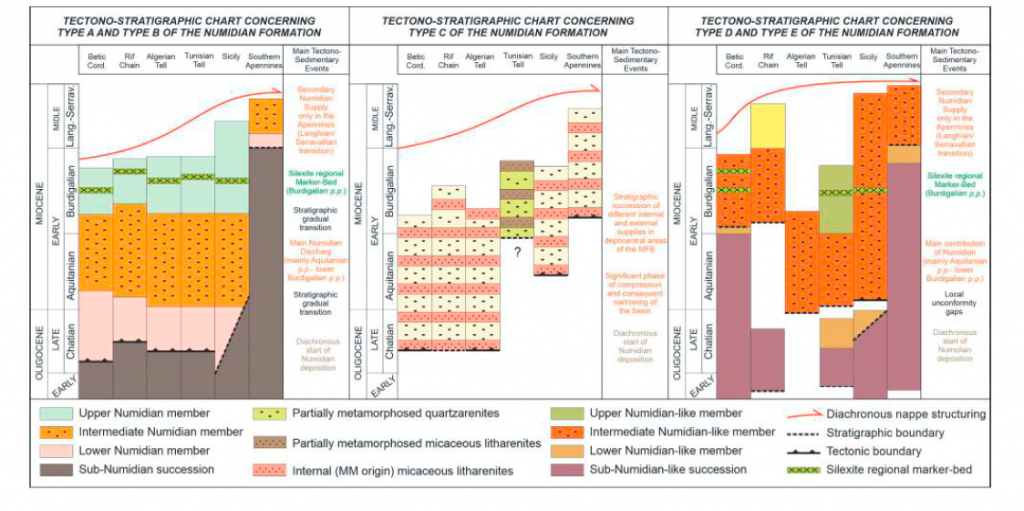Home » Posts tagged 'GPlates'
Tag Archives: GPlates
Cenozoic tectono-sedimentary evolution of the onshore-offshore Tunisian Tell: Implications for oil-gas research
A review of the paleogeographic and tectonic reconstruction of the onshore and offshore Tunisian margin during the Cenozoic is discussed. Five unconformities (A to E) and associated stratigraphic gaps of various vertical extents allow subdivision of the stratigraphic record into depositional units in the following time intervals: (i) Paleocene-Oligocene, (ii) Oligocene-early Aquitanian, (iii) early Aquitanian-Burdigalian, (iv) late Burdigalian-Langhian and (v) Langhian-late Miocene. These intervals can in turn be grouped into four main sedimentary cycles (SC1–SC4) dated to the (1) Paleocene-Oligocene, (2) Oligocene–Burdigalian, (3) Burdigalian-Langhian and (4) Langhian-late Miocene. The oldest depositional unit reflects Eo-Alpine tectonics in the Maghrebian Flysch Basin (MFB); the others are related to the Neo-Alpine syn- and late orogenic tectonic deformation affecting the MFB. The uppermost unit represents post-orogenic deposition. Early Miocene synsedimentary tectonism led to (1) deposition of thick successions owing to a large sediment supply and (2) the occurrence of various tectofacies (unconformities, slumps, mega-turbidites, olistostromes, growth folds, chaotic intervals and heterogenous lithofacies), that all, together with the occurrence of lateral change of facies, clearly indicate non-cyclical sedimentation. During the middle Miocene the Tunisian Tell underwent polyphase thrust tectonism, followed by late Miocene strike-slip deformation with contemporaneous rejuvenation of halokinetics and magmatism (the La Galite Archipelago) that may be traced as far as the Algerian Tell. The margin experienced deep-seated compressional tectonism during the Paleogene, a foreland basin during the early Miocene, and nappe stacking during the middle Miocene, with the occurrence of wedge-top sub-basins. The evolution of the region makes the existence of petroleum resources within either the thrust belt, the foredeep and/or the foreland systems plausible. Oil and/or gas may have been trapped in either i) deep buried allochthonous thrust wedges that are located below the Numidian Nappes, and/or in ii) the imbricate Medjerda Valley domain of the Tell foredeep. The offshore area between northern Tunisia and the La Galite Archipelago may also hold potential for large oil/gas fields, as has been confirmed by exploration of the same overthrust belt in other areas such as in Sicily and the Southern Apennines.

Hypothetical Tunisian margin offshore (revised after Belayouni et al., 2013).
Cite as: Belayouni, H., Guerrera, F., Martín-Martín, M., Tramontana, M., Bullejos, M. (2023). Cenozoic tectono-sedimentary evolution of the onshore-offshore Tunisian Tell: Implications for oil-gas research. Marine and Petroleum Geology 156 (2023) 106426
The Numidian formation in the Central-Western Mediterranean
The widely debated late Oligocene-middle Miocene Numidian Fm (NF) consists of supermature quartzose sediments deposited in the Maghrebian Flysch Basin (MFB) outcropping from the Betic Cordillera to the Southern Apennine passing by the Maghrebian Chain. The NF is commonly composed of three lithostratigraphic members and is characterized by two vertical successions (Type A and Type B) corresponding to different sedimentation areas in the MFB. It is noteworthy the occurrence of widespread lateral successions of the NF (Types C, D and E) indicating in some cases an interference of the Numidian sedimentation with other different depositional systems and supplies. The Type C ‘Mixed Successions’, deposited in depocentre areas, are composed of supermature Numidian supply interfingering with immature siliciclastic materials, coming from the internal portion of the MFB. The Type D consists of supermature Numidian materials supplied from the Africa Margin (external sub-domains) deposited in sub-basins on the Africa-Adria margins, outside the typical Numidian depositional area. The Type E, which stratigraphically overlies both the South Iberian Margin (SIM) and the Mesomediterranean Microplate (MM), represents the migration of the Numidian depositional system to reach the opposite margins of the MFB. The occurrence at a regional scale of all the above-mentioned lateral successions reveals a great evolutionary complexity resulting also from further constraints, which must be considered for palaeogeographic and palaeotectonic reconstructions. Another important point deals with the diachronism of the top of the NF, observed eastward from the Betic-Rifian Arc and the Algerian-Tunisian Tell (Burdigalian p.p.) to Sicily (Langhian p.p.) and up to the Southern Apennine (at least Langhian/Serravallian boundary) which can be related with eastwards delay in the MFB closure.

The palaeogeographic reconstruction of the Numidian depositional area presented in this paper,which is also included into a global kinematic model, represents a first attempt to use the software GPlates for this subject.
Cite as: Belayouni, H., Guerrera, F., Martin-Martin, M., Le Breton, E., and Tramontana, M. (2023). The Numidian formation and its Lateral Successions (Central-Western Mediterranean): a review. International Geology Review, DOI: 10.1080/00206814.2023.2199429
Recent Comments